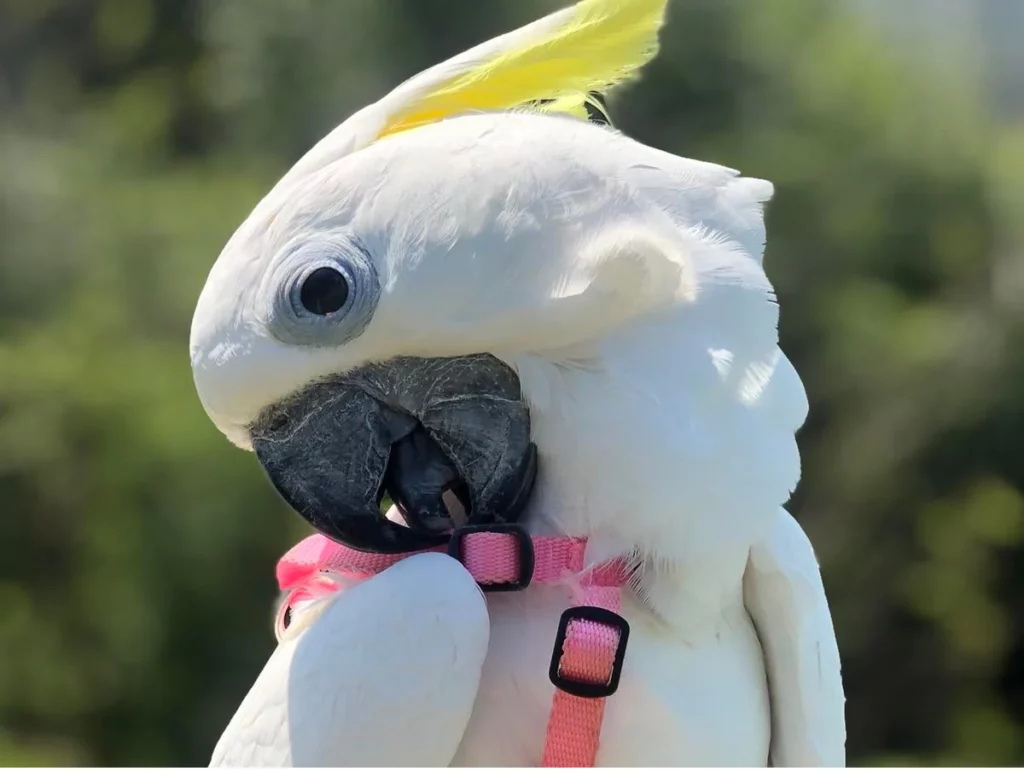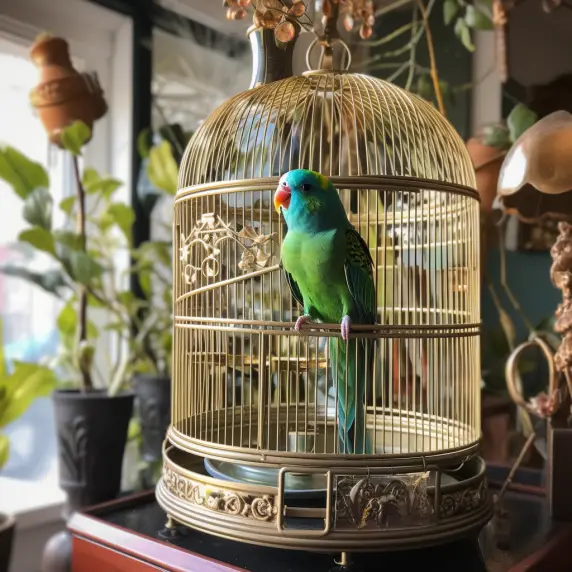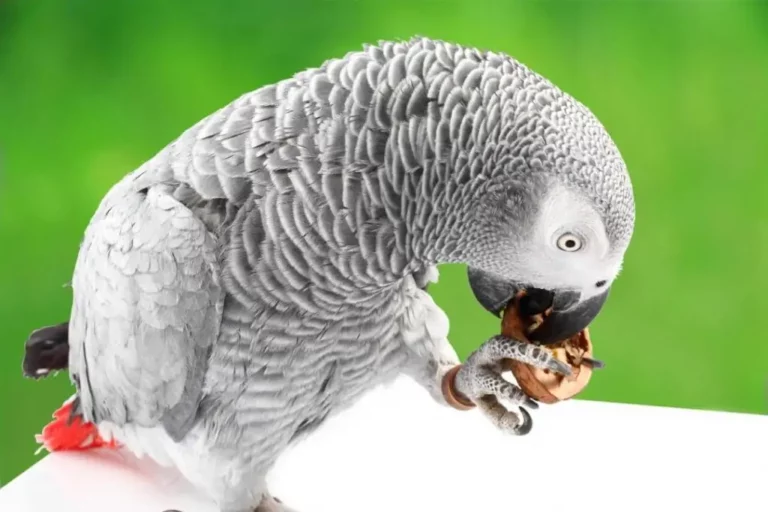Harness Training Your Bird for Safe Outdoor Adventures
Harness training is an essential skill for pet birds, allowing them to safely explore the outdoors with their owners. By teaching your bird to wear a harness, you can ensure their safety while also offering them the opportunity to experience the world beyond their cage.
The ability to control your bird’s movements while outside reduces the risk of injury, escape, or predation.
There are numerous benefits to taking your bird outdoors, including increased mental stimulation, exercise, and exposure to natural sunlight, which can aid in calcium absorption and overall health.
These experiences can help reduce boredom, strengthen the bond between you and your bird, and contribute to a happier, healthier pet.
In this blog post, we will walk you through the process of harness training your bird, including choosing the right harness, preparing your bird for training, following a step-by-step guide, and transitioning to outdoor adventures.
We will also discuss the pros and cons of harness training and offer valuable tips for success. By the end of this post, you will be well-equipped to begin harness training your bird for safe and enjoyable outdoor experiences.
Choosing the Right Harness for Your Bird
1. The Different Types of Harnesses Available
There are several types of harnesses on the market designed specifically for birds, ranging from basic leash-and-loop designs to more advanced avian harnesses with integrated elastic leashes. When choosing a harness for your bird, consider factors such as ease of use, adjustability, and comfort.
Look for a harness specifically designed for birds, as other pet harnesses may not provide the necessary level of security and control.
2. Sizing and Fitting Considerations
Selecting the correct size and fit for your bird’s harness is crucial to ensuring their comfort and safety. Many harnesses come in different sizes based on the bird species, so consult the manufacturer’s guidelines or consult with your avian veterinarian for assistance.
When fitting the harness, ensure that it is snug but not too tight, allowing your bird to move comfortably without the risk of slipping out.
3. The Importance of High-Quality Materials and Construction
When choosing a bird harness, prioritize high-quality materials and construction. The harness should be made from durable, lightweight materials that can withstand the elements and your bird’s natural inclination to chew.
Metal components, such as buckles and clips, should be rust-resistant, and the stitching should be strong and secure. Investing in a well-made harness will not only provide a more comfortable experience for your bird but also ensure their safety during outdoor adventures.
Preparing Your Bird for Harness Training
Building Trust with Your Bird
Before beginning harness training, it is essential to establish a strong bond and trust with your bird. Spend time interacting with your bird daily, talking to them, offering treats, and engaging in play. A trusting relationship will make the harness training process smoother and more enjoyable for both you and your bird.
Introducing the Harness Slowly and Positively
Introduce the harness to your bird in a positive and stress-free manner. Place the harness near your bird’s cage or play area, allowing them to become familiar with its presence. Over time, gradually bring the harness closer to your bird and encourage them to touch and interact with it.
Reward your bird with praise and treats to create a positive association with the harness.
Creating a Comfortable Environment for Training
To help your bird feel more at ease during harness training, ensure that the training environment is calm and comfortable. Minimize distractions such as loud noises, other pets, or sudden movements that might startle your bird.
It is also a good idea to conduct training sessions at a consistent time and place, allowing your bird to become familiar with the routine. Maintaining a relaxed and comfortable atmosphere will help your bird feel more confident and receptive to the harness training process.
Step-by-Step Guide to Harness Training Your Bird

1. Familiarizing Your Bird with the Harness
Begin the harness training process by allowing your bird to become familiar with the harness’s touch and feel. Drape the harness gently over your bird’s body, letting them get used to the sensation. Do not secure the harness at this stage; instead, focus on building your bird’s confidence and comfort with the harness.
2. Teaching Your Bird to Step Up onto the Harness
Once your bird is comfortable with the harness, teach them to step up onto it. Hold the harness in one hand and encourage your bird to step onto it using a vocal cue or by gently tapping their feet with the harness. Reward your bird with praise and treats when they successfully step onto the harness.
Repeat this process until your bird consistently steps onto the harness without hesitation.
3. Securing the Harness on Your Bird
After your bird is comfortable stepping onto the harness, it’s time to secure it onto their body. Gently and slowly secure the harness, ensuring that it fits snugly but comfortably. Be mindful of your bird’s body language and stress levels throughout the process and provide plenty of reassurance and praise.
Allow your bird to wear the harness for short periods, gradually increasing the duration as they become more comfortable.
4. Gradually Increasing the Time Your Bird Spends in the Harness
As your bird becomes more comfortable wearing the harness, gradually increase the amount of time they spend in it. Start with a few minutes per session and work up to longer periods over time. Always monitor your bird’s stress levels and remove the harness if they show signs of discomfort or anxiety.
5. Practicing Walking with Your Bird in the Harness
With your bird comfortable in the harness, practice walking together. Start by taking a few steps in your home or another familiar environment, gradually increasing the distance you walk. Provide plenty of praise and encouragement and be patient as your bird adjusts to this new experience.
Practicing walking together indoors will help prepare your bird for the transition to outdoor adventures.

Transitioning to Outdoor Adventures
1. Choosing the Right Location for Outdoor Outings
When planning your first outdoor excursion with your harnessed bird, select a location that is calm, quiet, and free from potential hazards. Avoid areas with loud noises, heavy traffic, or large numbers of people, as these can be overwhelming for your bird.
A quiet park, backyard, or secluded outdoor space is ideal for introducing your bird to the outdoors.
2. Preparing for Potential Distractions and Hazards
Before venturing outdoors, prepare for potential distractions and hazards by familiarizing yourself with the environment and considering any risks it may pose. Keep an eye out for potential predators such as larger birds, cats, or dogs, and be prepared to protect your bird if necessary.
Be mindful of weather conditions, as extreme temperatures, strong winds, or rain can cause discomfort or stress for your bird.
3. Gradually Increasing the Duration of Outdoor Excursions
Start with short outdoor excursions, allowing your bird to adjust to the new environment and sensations. Gradually increase the duration of your outings as your bird becomes more comfortable and confident outdoors.
Always monitor your bird’s body language and stress levels, ensuring that they are enjoying the experience and not becoming overwhelmed.
4. Monitoring Your Bird’s Body Language and Stress Levels
Pay close attention to your bird’s body language and stress levels while outdoors. Signs of stress can include excessive vocalization, panting, ruffled feathers, or attempts to escape from the harness. If your bird appears stressed or uncomfortable, calmly remove them from the situation and provide reassurance.
Remember that your bird’s safety and well-being should always be your top priority during outdoor adventures.
The Pros and Cons of Harness Training
The Benefits of Harness Training
Harness training offers numerous benefits for both you and your bird. It allows your bird to safely explore the outdoors, providing mental and physical stimulation, exposure to natural sunlight, and the opportunity to bond with you in a new environment.
A well-trained bird can enjoy outdoor adventures without the risk of escape or injury, enriching their life and overall well-being.
The Potential Challenges and Drawbacks
Despite its many benefits, harness training can pose challenges and drawbacks for some birds and their owners. The training process requires patience, consistency, and a strong bond with your bird, which may be difficult for some owners to achieve.
Additionally, some bird species may be more prone to stress or anxiety, making harness training unsuitable for them. In some cases, the harness may cause discomfort or irritation if not fitted properly or if your bird has sensitivities to the materials used.
Evaluating Whether Harness Training is Right for Your Bird
Before embarking on the harness training journey, carefully consider whether it is the right choice for your bird. Research your bird’s species to determine if they are suitable candidates for harness training and evaluate your own ability to provide the necessary time, patience, and commitment.
Consult with an avian veterinarian or an experienced bird trainer for personalized advice and guidance. Remember that the ultimate goal is to enhance your bird’s quality of life, so it is essential to weigh the potential benefits against any risks or challenges involved.
Tips for Successful Harness Training
Utilizing Positive Reinforcement
Throughout the harness training process, use positive reinforcement to encourage and reward your bird’s progress. Offer treats, praise, and affection whenever your bird shows interest in the harness, steps onto it, or wears it without stress.
This will help create a positive association with the harness and make training more enjoyable for both you and your bird.
Establishing a Consistent Routine
Consistency is key when it comes to successful harness training. Establish a regular routine for training sessions, ideally conducting them at the same time and place each day. This will help your bird become familiar with the process and feel more at ease during training.
Being Patient and Adjusting Your Approach as Needed
Patience is crucial during harness training, as some birds may require more time and repetition to become comfortable with the harness. If your bird shows signs of stress or anxiety, take a step back and adjust your approach as needed.
Remember that every bird is different, and what works for one bird may not work for another. Always prioritize your bird’s well-being and avoid pushing them too far too quickly.
Ensuring the Safety of Your Bird at All Times
Throughout the harness training process and during outdoor adventures, always prioritize your bird’s safety. Monitor their body language, stress levels, and the environment for potential hazards or concerns. Be prepared to intervene if necessary and remember that your bird’s health and happiness should always come first.
By following these tips and maintaining a patient, positive approach, you can successfully harness train your bird and embark on safe and enjoyable outdoor adventures together.
Frequently Asked Questions
How long does it take to harness train a bird?
The time it takes to harness train a bird varies depending on the individual bird’s temperament, age, and prior experiences. Some birds may take to the harness quickly, while others may require weeks or even months of consistent training.
Can all bird species be harness trained?
While many bird species can be harness trained, it is essential to research the specific needs and tendencies of your bird’s species to determine if harness training is appropriate. Some species may be more prone to stress or injury and may not be suitable candidates for harness training.
Is it safe to take my bird outdoors without a harness?
Taking your bird outdoors without a harness is not recommended, as it poses significant risks. Even well-trained birds can be startled by unexpected noises or distractions, and a sudden flight could result in injury or loss.
What should I do if my bird is scared or stressed while in the harness?
If your bird appears stressed or frightened while in the harness, calmly and gently remove the harness and give your bird some space. It is essential to build trust and maintain a positive association with the harness, so be patient and adjust your approach as needed.
Final Thoughts
Harness training is an invaluable skill that allows you to safely share outdoor adventures with your bird. The process helps enrich your bird’s life by offering mental and physical stimulation, exposure to natural sunlight, and the opportunity to bond with you in a new environment.
With proper training, patience, and dedication, harness training can greatly enhance your bird’s overall well-being and quality of life.
We encourage you to consider harness training your bird and taking them on safe outdoor adventures. By following the guidelines and tips provided in this blog post, you can help ensure a successful and enjoyable harness training experience for both you and your bird.
Remember that every bird is different, and the key to success is patience, consistency, and a strong bond with your feathered friend.
We invite you to share your own harness training experiences, challenges, and successes in the comments section below. Your insights and tips can be valuable to fellow bird owners embarking on their own harness training journey.
Let’s create a supportive community that encourages and empowers bird owners to enhance their birds’ lives through safe and enjoyable outdoor adventures.
Additional resources:






